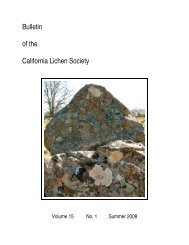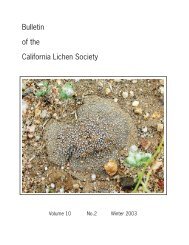Volume 10(1): Summer 2003 - The California Lichen Society (CALS)
Volume 10(1): Summer 2003 - The California Lichen Society (CALS)
Volume 10(1): Summer 2003 - The California Lichen Society (CALS)
Create successful ePaper yourself
Turn your PDF publications into a flip-book with our unique Google optimized e-Paper software.
Bulletin of the <strong>California</strong> <strong>Lichen</strong> <strong>Society</strong> <strong>10</strong>(1), <strong>2003</strong><br />
communities. New Zealand, however, might be<br />
expected to be overall a better environment for<br />
lichens than <strong>California</strong> in view of its low human<br />
population density (Table 1) and correspondingly<br />
low atmospheric pollution, including acid rain, and<br />
the species richness numbers in Table 1 suggest that<br />
it is a better environment.<br />
Lowland Rainforest<br />
About 40 km north and east of Wellington, the<br />
capital city, is the southern end of the Tararua<br />
Range, part of a 190 km long spine in the lower<br />
third of the North Island with peaks reaching 1570<br />
m (5150 ft.). It is comparable to the Coast Ranges of<br />
<strong>California</strong>, separating the west coast which fronts<br />
on the Tasman Sea, that part of the Pacific Ocean<br />
separating New Zealand from Australia, from the<br />
Wairarapa Valley, comparable on a small scale to the<br />
Central Valley of <strong>California</strong> (although its climate is<br />
more like that of the Napa Valley). This part of<br />
the Tararuas is temperate lowland mixed beech<br />
(Nothofag us, Fagaceae) rain forest and looks more<br />
like coastal Washington State than <strong>California</strong> with<br />
tree trunks and the ground covered by bryo phytes<br />
and lichens (contrary to a theory advanced<br />
once on the Honolulu listserver that, when the<br />
mosses become luxuriant, the lichens recede). <strong>The</strong><br />
appearance is something like the wet coastal forests<br />
of <strong>California</strong> dominated by Pseudotsuga and Sequoia.<br />
<strong>The</strong>re are, of course, almost no vascular species in<br />
common. Nothofag us menziesii, the silver beech<br />
(the closest thing New Zealand has to a native<br />
oak) along with N. fusca and perhaps N. solandri<br />
is plentiful in this forest bordering the Waingawa<br />
River. I found other hardwood tree species as well,<br />
like kamahi, Weinmann ia racemosa (Cunoniaceae),<br />
and Five-finger, Pseudopan ax arboreus (Araliaceae),<br />
and a dense understory of shrubs like Coprosma<br />
(Rubiace ae), some of which are garden subjects in<br />
<strong>California</strong>.<br />
At the Mt. Holdsworth entrance to Tararua Forest<br />
Park west of Masterton, Pseudocyphellaria and Sticta<br />
take the place of the Parmeliaceae in <strong>California</strong>, with<br />
huge thalli hanging from tree branches and wet,<br />
bright green, muscicolous-terricolous individuals<br />
growing like lettuce along the trail (more than a<br />
third of Pseudocyphellar ia species here have green<br />
algal photobionts). I have not seen a statistical<br />
survey of this situation, but as early as 1865 the<br />
Scottish lichenologist, W. Lauder-Lindsay (quoted<br />
by Galloway 1985), noted a similar replacement<br />
on the South Island. Although <strong>California</strong> has its<br />
Pseudocyphellar ia species, three to be exact with a<br />
fourth, P. rainierensis, hoped for in Del Norte County,<br />
New Zealand has 50 Pseudocyphellari as according<br />
to Malcolm and Galloway (1997). Galloway (1985)<br />
notes that New Zealand and southern South<br />
America are the two great centers of speciation<br />
for this genus. One of the most remarkable species<br />
is P. coronata (figs. 1 and 2, back cover) in which<br />
red-brown pigment can be seen with the naked<br />
eye in natural cracks in the upper cortex. I did not<br />
observe it in pseudocyphellae of the lower cortex.<br />
A tangential removal of cortex (Hale 1979, p. 11)<br />
shows scattered red-brown areas at the interface<br />
between algal layer (green) and the yellow medulla.<br />
At 400x these are seen to be aggregations of fine,<br />
K+ purple, probably crystalline granules. Polyporic<br />
acid and unidentified anthraquin ones have been<br />
reported (C. Culberson 1969, 1970; C. Culberson et<br />
al. 1977) along with an array of 9 triterpen oids and<br />
3 pulvinic acid-related substances. In connection<br />
with the use of this lichen to produce fabric dyes<br />
Galloway (1985) notes: “Very often populations are<br />
devastated by collectors who imagine that because<br />
the lichen is usually well-developed and also often<br />
common, it must regenerate quickly. In the interests<br />
of conserving New Zealand’s unique lichen flora the<br />
use of lichens for dyeing must be strongly condemned”<br />
(italics mine). <strong>The</strong>re are simply not enough lichens<br />
left in New Zealand or in <strong>California</strong> to be harvesting<br />
them on the scale required for making dyes.<br />
Another Pseudocyphellaria with a quite different,<br />
dissected appearance is P. episticta (fig. 3, back<br />
cover). It occurs inside the forest with Sticta (S.<br />
subcaperata, fig. 4, back cover) and is characteristic<br />
of partially shaded situations. I found it also in the<br />
Johnston Hill Reserve not far from my home in the<br />
city of Wellington. <strong>The</strong>re are 13 species of Sticta<br />
in New Zealand (perhaps three in <strong>California</strong>) of<br />
which the evidently fairly common S. subcaperata<br />
is representative. <strong>The</strong> thallus photographed had<br />
fallen from a tree on the Waingawa River.<br />
Usneas, of which Galloway (1985) lists 16 for New<br />
Zealand (Tavares [1997] gives 24 for <strong>California</strong> in<br />
her preliminary key), are on trees and shrubs in<br />
well-lit places in the rainforest, including several<br />
“reds”, all subsumed by Galloway under U.<br />
2





